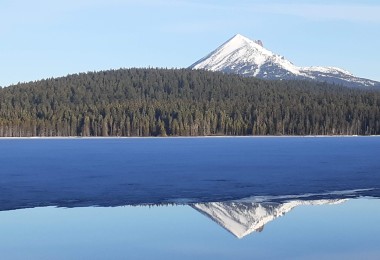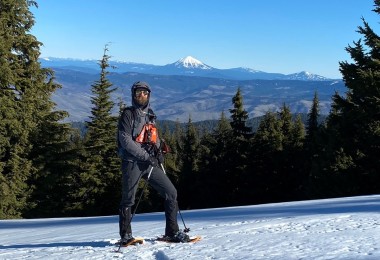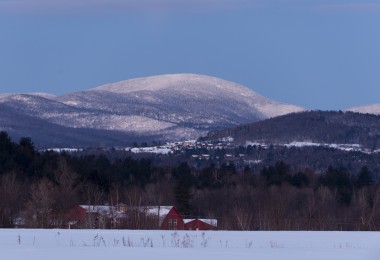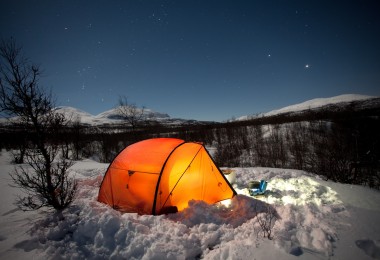To read Part One, visit the following link: https://www.snowshoemag.com/view_content.cfm?content_id=191.
When some people begin hiking on snowshoes, they develop what French-Canadian trappers called mal de racquette—snowshoe sickness. This involves a cramped contraction of muscles in the leg and instep that can disable a person for days. To avoid this malady, snowshoe only an hour or so the first time out. Lengthen the sessions gradually on successive outings.
As long as your straps are cinched tightly, walking in snowshoes is, well, a cinch. It is handy for snowshoers to carry a ski pole as an aid to forward progress, balance, going up and down hills and regrouping from spills. The use of poles also gets the upper body moving in a manner similar to cross-country skiing, thus improving the quality of a workout. Going uphill and downhill requires some energy and careful stepping.
Water, a container of hot chocolate or coffee and high-energy snacks should go into your Mt. Hood daypack, along with a map, compass, pocketknife, sunglasses and first-aid kit. Also bring along an extra pair of socks, sunscreen, and a few pieces of heavy string to make temporary snowshoe repairs.
Snowshoe enthusiasts describe a typical winter’s day in the Mt. Hood National Forest as one that is fun, exciting and an ideal way to get around. One of the most frequent observations made among enthusiasts is that snowshoes allow a traveler a quiet means of roaming the winter landscape; in and around Mt. Hood, that covers a considerable amount of territory.
Where to Snowshoe on Mt. Hood. Following is information on a number of Mt. Hood snowshoe trails. Many of the better-developed trail systems on the mountain are groomed throughout the week by volunteers, so those persons who can hit the great outdoors on weekdays have the same high-quality conditions as those who can only make it out on the weekends.
Summit Meadow Cabins near Trillium Lake offers lodging that one has to snowshoe or cross-country ski to get to in the winter months. The owner, Wendy Evans, can be contacted at info@summitmeadow.com; tel. 503-272-3494. Other lodging options include the historic Timberline Lodge and the modern Collins Lake Resort.
The Glade Trail, which connects Government Camp at 4,000 feet with the Timberline Lodge at 6,000+ feet, is open once a year for an event that features food and entertainment. The date for 2006 has not yet been set. The event is put on by the Mt. Hood Cultural Center & Museum in Government Camp, Oregon, which facility can be contacted at www.mthoodmuseum.org, or 503-272-3301. The Mt. Hood National Forest (http://www.fs.fed.us/r6/mthood/recreation/winter/current-conditons.shtml.) has great links to detailed information on area snowshoe trails.
One of my favorite places to snowshoe is in Mt. Hood’s White River Canyon. This three-mile hike features stunning views of Oregon’s highest peak.
From the Sno-Park at White River West, the trail leads northeast across a flat, open meadow toward Mt. Hood’s imposing 11,239-foot summit. To the right lies a broad canyon gouged by the White River, which river parallels the hiking route.
A quarter-mile into the trail is one of the mountain’s most popular sledding spots, known as “the pit,” because it was once used as a rock quarry. Families flock here on winter weekends to plunge down the steep bowl on the left. Beyond this point, snowshoers are left alone to enjoy the majesty of the mountain. After a mile, the trail leads up a short but steep hill and follows the ridgeline for another half-mile to a set of power lines passing overhead, marking the turnaround for this three-mile hike.
On the return trip, hikers can simply retrace their steps or, for a more secluded experience, keep right and follow the tree-lined ridge through a dense pine forest trail marked with blue diamonds back to the trailhead. From Portland, travel east on Highway 26 for 54 miles, then turn north on Highway 35 toward Hood River. Continue four miles to White River West Sno-Park on the left. A Sno-Park permit ($3/day; $15/year) is required. For more information call the Zigzag Ranger District at 503-668-1700.
Other popular Mt. Hood trails include Lolo Pass (http://www.fs.fed.us/r6/mthood/recreation/winter/snoparks/lolo-pass.shtml), Trillium Lake (http://www.fs.fed.us/r6/mthood/recreation/winter/snoparks/trillium-lake.shtml), and Glacier View (http://www.fs.fed.us/r6/mthood/recreation/winter/snoparks/glacier-view.shtml). Additional information about snowshoeing on Mt. Hood can be obtained from Megan Conway, Media Relations Manager, Oregon’s Mt. Hood Territory, megan@mthoodterritory.com, tel. 503-275-9786.
Besides making certain you know where you’re going (and how to get back to where you started from), there is one important rule to follow when snowshoeing on Mt. Hood: If your route takes you near one of the many groomed trails used primarily by cross-country skiers on public lands, be careful not to destroy the track made by skiers. Though snowshoers often use the parking lots at the trailhead for marked ski trails, be courteous and parallel the ski trail as much as possible until you are able to leave the trail system altogether. After all, that’s the best thing about bushwhacking on snowshoes. You get to choose your own path, and in the Mt. Hood National Forest, those paths are virtually limitless.
Some old hands at snowshoeing talk privately about a “oneness” with nature. This involves something in the harsh but invigorating winter wind, a part of the snowshoer’s world where cold weather redefines one’s being in an unanticipated but enjoyable way. There is something in snowshoeing’s simplicity and closeness to the natural world that speaks to an increasing number of people who seek to live with nature, rather than dominate it. Enjoy.





